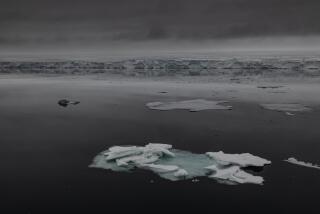Air Over Antarctica Is Warming, Scientists Say
In the winter sky over Antarctica, scientists have detected a vast cap of steadily warming air, in the first sign that record levels of greenhouse gases in the atmosphere may be trapping heat above the ice sheets of the South Pole.
The temperature of the winter air over Antarctica has been rising at a rate three times faster than the world as a whole, the researchers reported Thursday in the journal Science.
By analyzing 30 years of high-altitude weather balloon records, meteorologists at the British Antarctic Survey in Cambridge, England, concluded that temperatures in the polar troposphere -- the dense layer of air reaching from the surface to an altitude of about 5 miles -- have risen by 3.6 degrees Fahrenheit since the early 1970s.
“We have the largest regional warming on Earth at the tropospheric level,” said climate specialist John Turner, who led the research team.
As levels of carbon dioxide in the atmosphere worldwide rise to levels not seen for a million years, the ice sheets of Antarctica -- the world’s largest reservoir of fresh water -- are shrinking faster than new snow can fall.
But no one knows whether the heat-trapping effects of atmospheric pollution or nature’s own enigmatic cycles of change are the cause.
For scientists trying to understand the consequences of rising temperatures, Antarctica always has been a world unto itself -- the highest, driest, windiest and coldest continent on Earth, isolated by the broad Southern Ocean -- where the extremes of weather routinely confound the computer models used to predict climate trends.
The dramatic warming in the air over Antarctica made public Thursday was nowhere evident in any of the climate models on which global warming forecasts are based, Turner said.
The researchers checked their finding against 20 computer simulations used by the United Nations’ Intergovernmental Panel on Climate Change to replicate past climate patterns and make predictions about the future.
In their study, Turner and his colleagues drew on daily temperature records covering the years from 1971 to 2003 kept by eight international research stations that rim Antarctica and by the U.S. Amundsen-Scott Station at the South Pole.
It was the first time anyone had been able to collate all the high-altitude atmosphere readings.
When the researchers examined the data, they not only saw evidence of a winter season warming throughout the troposphere, but a cooling in the stratosphere above -- a layering effect that researchers had predicted as a consequence of greenhouse warming.
“We have the classic global warming signal,” Turner said. “It is like the blanket on the bed: When we wrap the Earth with a blanket of greenhouse gases like carbon dioxide and methane, we trap heat under it at the expense of the atmosphere above, which then cools.”
The new finding about Antarctic warming is particularly important, several experts said, because until now researchers had only partial -- and often conflicting -- temperature readings from a few surface stations on the icy continent. Even as one weather station had reported the fastest warming of anywhere on Earth, others simultaneously reported seasonal cooling.
Even so, the discovery has only deepened the mystery for those who study the climate at Earth’s polar extremes.
“I think it is a very significant finding and I completely trust the science,” said meteorologist David Bromwich at the Byrd Polar Research Center at Ohio State University in Columbus. “But what it all means is a very good question. They make a case that it might be related to an increase in greenhouse gases, but that’s not proven at all.”
Climate experts were especially surprised that the consistent warming trend detected in the atmosphere had no apparent effect on surface temperatures.
Some wondered whether powerful polar winds, which have progressively strengthened during the last 40 years, might be partly responsible. The influence of the annual ozone hole over Antarctica also may be driving climate changes across the continent.
“If it is warming up, what is going on here?” said polar atmosphere expert Thomas Parish at the University of Wyoming in Laramie. “It is hard for us to interpret. Is this natural or is this man-induced? I really don’t know.”






